Part 4: Old marketing assumes that someone was reading your ads. Now, if you want customers to pay attention, try These People Media™ Techniques.
Jay Abraham is a marketing genius. He has been praised by Tony Robbins, Ken Blanchard, Steven Covey, Mike Basch (the founder of FedEx) and Harvey Mackay. You can hire him for $5,000 an hour and he will solve your marketing problems and make you a pile of money. Or, you could read his book, Getting Everything You Can Out of All You’ve Got and he will tell you his secrets. (New copies go for about $65 on Amazon, used copies are much less.) Now, why would Jay Abraham tell all his secrets in a book anyone can buy? Because he knows that lots of people will buy his book, but only about one percent of the people who buy his book will study it carefully and use the information. Most of the people who do so are people like me … pros who must study every single thing they can so that they can apply new information to help their time-starved clients make money.
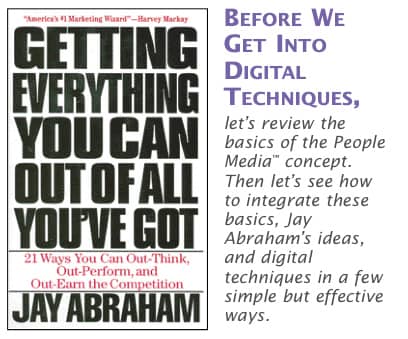
The furniture retailing world is changing so fast furniture retailers have to work twice as hard to stay ahead of the pack. Jay Abraham is all about People Media™. His ideas were profiled in the FURNITURE WORLD article, Visionary Selling - Part 1 - Take The Time To Understand & Deliver Priceless Value that is posted to the Marketing Management article archives on www.furninfo.com. In this issue we will take some of his concepts to another level and begin to integrate them with emerging digital techniques. A “People Media™” digital age is fast approaching that offers an opportunity for independent home furnishings retailers to relate to their communities in ways that will make marketing easier. They will be able to expand market share because they can use People Media™ techniques in ways that the big boxes cannot.
Your digital People Media™ skills could eventually determine your survival as a furniture store in the decades ahead. Regardless of the size of your business, and even if you have a chain of stores, time is running out for you to establish a footprint in cyberspace that helps you develop a personal relationship with customers. Before we get into digital techniques, let’s review the basics of the People Media™ concept. Then let’s see how to integrate these basics, Jay Abraham’s ideas, and digital techniques in a few simple but effective ways.
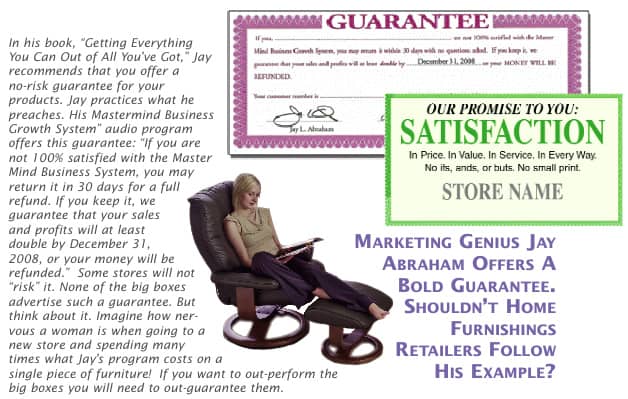
Your People Media™ are any and all factors relating to your store that enter the consciousness of associates, customers, vendors, prospective customers, their friends, and the community at large. Many of these factors are beyond your direct control, but they are all influenced by the culture of your organization and you are responsible for that. The factors influencing culture are wide and varied, but if you get them right, everything else regarding morale and attitude will be relatively easy. There are the basic material issues, of course. The condition of the parking lot, the general appearance of the store and staff, the way associates answer the phone, even the wholesomeness of the bathrooms speak to customers and associates. They either say we are professionals who master every detail of the shopping experience, or they say something else. The take home message: People Media™ determine the culture of a company, and the CEO can never, ever delegate this leadership responsibility.
TWO KINDS OF STORES WILL SURVIVE
In the last article of this series it was stated that only two kinds of furniture stores will survive the current crisis: The old-fashioned, no-service “stack ‘em up and blow ‘em out stores, and the stores that adopt new marketing techniques to tell their story. If you are service oriented, open-minded, and hungry, there are techniques you can use to take advantage of the most exciting opportunities in home furnishings history. A few dealers contacted FURNITURE WORLD to ask if the article implied that outlet stores would have no role in the future. Not so. They have a huge role to play if they adopt new marketing techniques to tell their story.
Jay Abraham is all about telling your story by means of People Media™. He has a disarmingly simple approach to marketing, and therein lies his genius. There are three ways, and only three, to increase your sales volume, Abraham says. Adjusted to furniture lingo, they are:
• Increase your number of customers.
• Increase the size of your tickets.
• Increase the number of times your customers visit your store.
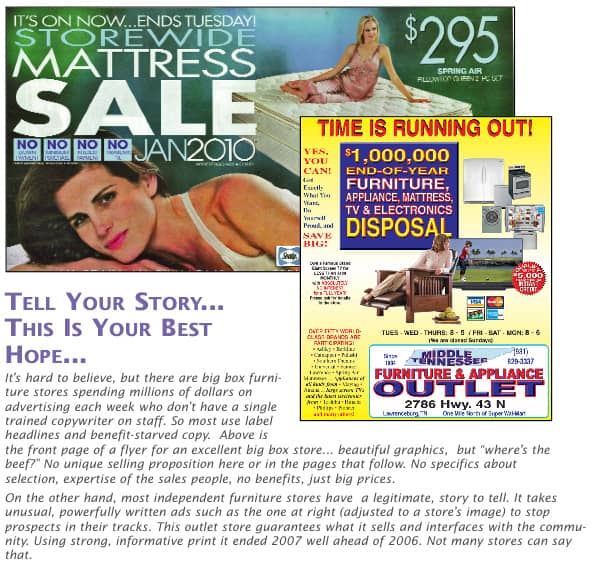
The balance of Jay’s program consists of creative techniques to do all three of the above. According to Jay, if you could increase your effectiveness by a mere ten percent in each of the above categories, you would double your volume. (He does the math; it works. Check it out.) Now that you have this simple solution in mind, you are ready to take the next step, that will get you started making the digital revolution work for you.
FIRST: Increase Your Number Of Customers.
If the best you can do is the same thing your competitors are doing, nothing will change. Abraham uses the analogy of fishing. If you have one pole in the water you will land just so many fish. If you put ten poles in the water with different kinds of bait you will attract and land ten times as many. Ten poles? Sure thing:
1. Direct Mail: You need a good bought list, and a regular program of effective, varied mailings at least six times a year. Capture names for your inner-circle, preferred customer list.
2. High Impact Events: A couple of store-run high impact events a year will add impressively to your bottom line and attract new customers.
3. In-store Seminars: Set up a program of in-store decorating seminars. Certain to attract new customers and make you stand out.
4. Shop At Home Program: Begin a Shop at Home program. Another excellent way to increase market share and attract new faces.
5. Use Email: Start capturing email addresses and set up a regular line of permission marketing with a younger generation of shoppers.
6. Advertise Smarter: Make your advertising two or three times more effective. Check out the article archives on www.furninfo.com for a wealth of articles on these subjects.
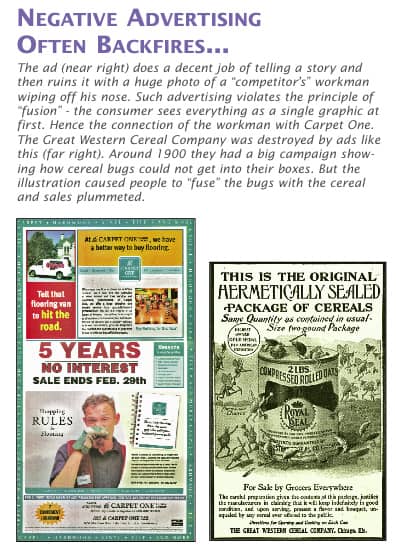
7. People Media™ Messages: Improve the People Media™ messages you are sending to your staff. Be positive, walk positive, talk positive, think positive. Forget recession. Abraham writes: “We are always living in uncertain times. And regarding the “R-word”, my advice is to forget it.”
8. Brainstorm In-house: Brainstorm with your staff about ways to increase traffic, and assign teams to investigate their ideas and the topics above and come up with action plans for getting programs started.
9. Pay More Attention To Your Website: Monitor your website at least weekly … and keep it up to date. Add a “stream” featuring you talking to website visitors.
10. Tell Your Story: Develop a handout that tells your story, give it to every customer, distribute it to your staff, mail it out… it is an eloquent spokesperson.
11. Cash In On The Giant TV Fad: Make a deal with a media store to set up a home entertainment display featuring your best reclining theatre group and one of their premier large screen TVs in both your store and theirs ... sign both displays appropriately and give discount coupons.
12. Adjust Sales Commissions: In between events, double the sales commission on any new customers a salesperson closes, and triple it for any they bring in by their own efforts. If this sounds nuts blame Jay Abraham. He gives some impressive stats in his book that make this move plausible. There, that’s ten plus two for good measure. How is that for exceeding your expectations? Your staff can come up with more. Just be sure someone, or a team, is responsible to put the best ones into action and report back on a specific date.
SECOND: IncreaseThe Size Of Your Tickets
This is so simple and powerful that it has been overlooked in recent years. The idea is that it costs a fortune to bring in a new customer. Each one is worth her weight in gold.
Lets say you have succeeded in bringing in a new customer who buys a beautiful leather sofa. Assume your net profit is only $100 when you consider the promotional cost of bringing her in, paying double sales commission, overhead, etc.. Your salesperson is sharp, however, and sells her the matching loveseat. Since you have already paid to bring her in and paid the overhead, all you need deduct is the sales commission. You make $300 profit on the loveseat. Your net just quadrupled on one transaction! Just imagine if you have trained your salesperson to add tables, lamps and on and on!
1. Spiffs: Spiff add-ons generously.
2. Add-On Contests: Have periodic contests for best add-on performances (number of items per ticket) rather than volume.
3. Fabric Protection: Spiff generously and promptly if you have a fabric protection program that works for you and provides value for your customers.
4. Step-Ups: Step-ups are equally powerful profit generators and should be done keeping the customer’s needs for the superior benefits of higher priced items in mind. Sales of more profitable goods can be encouraged with incentives based on the gross margin of items sold.
5. Delivery Incentives: Train the warehouse crew to understand the mathematics of careless damage to merchandise. Reward damage-free performances.
6. Brainstorm with the staff for other ways to plus the profit of each transaction. Reward the best ideas.
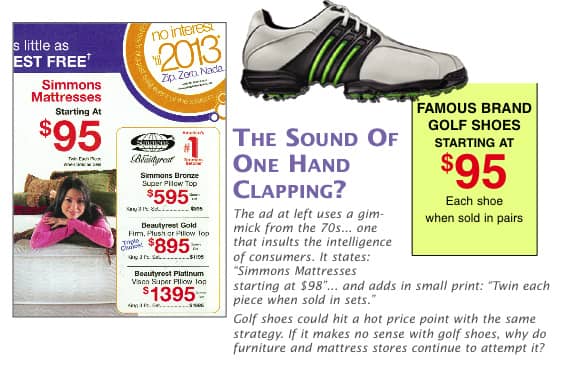
THIRD: Increase the number of times your customers visit your store.
Abraham says that, “When given an option or an incentive, people are willing to buy more than they ordinarily do.” This may seem to be appropriate for small ticket items only, but don’t pass it by too quickly.
1. Preferred Customer Lists: Special events are always welcome to customers who like your store. Not always a sales event. Several independents have annual open house events in which they have a couple of local celebrities, door prizes, refreshments, radio remote, etc. These are very well attended, wall-to-wall people.
2. E-Newsletters: Capture email addresses for a cyberspace newsletter. This is called permission marketing. It will become the wave of the future. A snail mail version is important as well. If your buyers return from market and go on-and-on about this product or that, but you never tell your customers about the newest trends, designs and fabrics, you are missing a big opportunity.
3. Decorating Clinics: Have a preferred customer decorating clinic. Maybe two or three.
4. Follow-Up: Salespeople must send thank you notes and follow-up sales with phone calls to make sure everything is ok. This actually reduces service calls.
5. Ask For Referrals: Referrals are the most powerful People Media™ tool of all. Jay Abraham says, “Start looking at your clients as dear and valued friends.” If this sounds corny, you are in the wrong business. Joe Girard, the “world’s greatest salesman”, came up with the idea of the “rule of 200.” He said we all have about 200 friends, family members, neighbors, colleagues and so forth who like us enough to take our recommendations. Girard built his business on referrals. How do you get them? You ask for them. Abraham has a referral template in his book that is dynamite (Chapter 11). You can also check out the excellent articles by Cathy Finney, “Too Chicken To Ask For Referrals?” - Parts 1 &2 that are posted to the Sales Education article archives on the furninfo.com website.
CONCLUSION
The key message here is that digital communication is changing marketing as we know it, and will eventually revolutionize it. Old marketing assumed that someone was watching your commercials, reading your ads, and paying attention to your salespeople. All you needed to do was interrupt prospects and give them a great sales pitch. But the truth is people are too busy now to pay attention.
They are bombarded with weak and hastily prepared advertising messages. The big boxes can afford to flood the market with weak advertising. Unless you are an advertising whiz, their sheer volume of messages will drown you out. But what they can’t afford to do is People Media™ on the scale that you can. And herein lies the opportunity for the furniture store of the future.
You will still need direct mail and persuasive print to tell your story for the foreseeable future. However, there is more to say about the online possibilities that will vault your store to another level of People Media™ communication. To do justice to cyberspace applications of People Media™ we will need yet another article.
NEXT ISSUE
The May/June issue of FURNITURE WORLD Magazine will feature a report by the Wall Street Journal on how brick and mortar small retailers are connecting online with customers by using live chats. We will also explore several other ways to propel your store past the competition with low cost digital techniques. In the meantime, trust that: The sky is not falling. Avoid the Chicken Little mindset.
Contributing Editor Larry Mullins has 30+ years experience in the front lines of furniture marketing. Over the past ten years he has developed a Visionary Management program that can impact the culture of an entire organization and bring it to life. He also produces state-of- the-art promotional advertising packages for everything from quick cash flow to complete exit strategies and store closings. Larry is the President of UltraSales, Inc.. Questions about this article can be sent to Larry care of FURNITURE WORLD to mullins@furninfo.com.